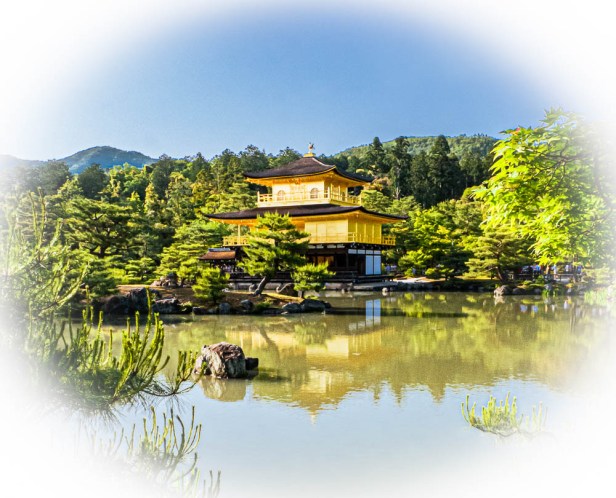
Extraordinary, iconic, and unusual buildings; a collection of images from around the world
Spain 2011
In southern Spain, just outside of the city of Granada is a vast compound of ancient buildings.
Known as the Alhambra, it is a conglomeration of 13th and 14th century palaces and gardens, the most spectacular and significant being from the days of the Moorish rule of southern Spain. The Alhambra is a breathtaking example of Islamic architecture; beautiful detailed decoration,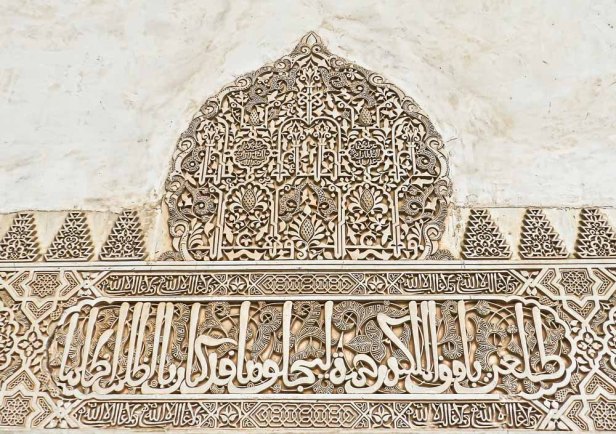
arched windows and colonnades,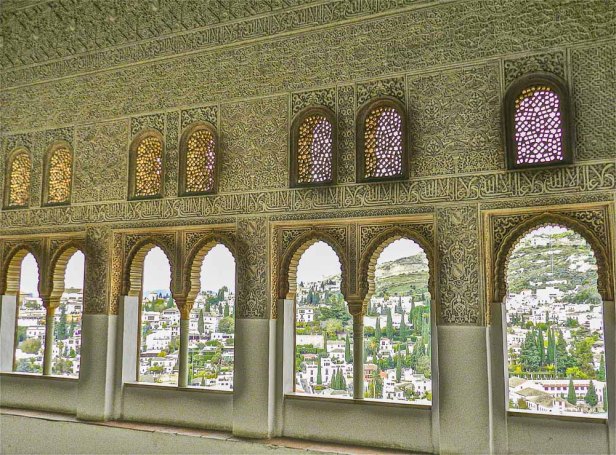
fountains and mirror lakes,
and formal gardens.
Everywhere there is beauty. The whole place is simply astonishing, and in the way of all palaces and palace complexes, the Alhambra is truly magnificent.
From the south of Spain to the north, to Barcelona.
There are no straight lines or sharp corners in nature. Therefore, buildings must have no straight lines or sharp corners. Antoni Gaudi.
It feels as if I’ve known about the work of Antoni Gaudi all my life. Certainly I learned about, and saw pictures of his buildings in high school art classes when I was a teenager and was immediately captivated. There is nothing ordinary about his work; it is all inventive, and incredibly creative, and magical. Every part of a building was a place for art.
Casa Batllo, an urban mansion built for the Batllo family in1904-06. The exterior,
and a glimpse of the interior.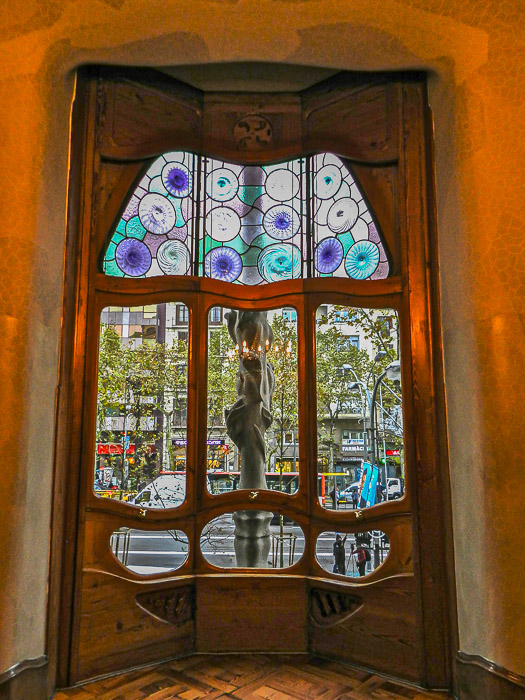
Casa Mila, an apartment building known as La Pedrera, built in 1905-10. The exterior,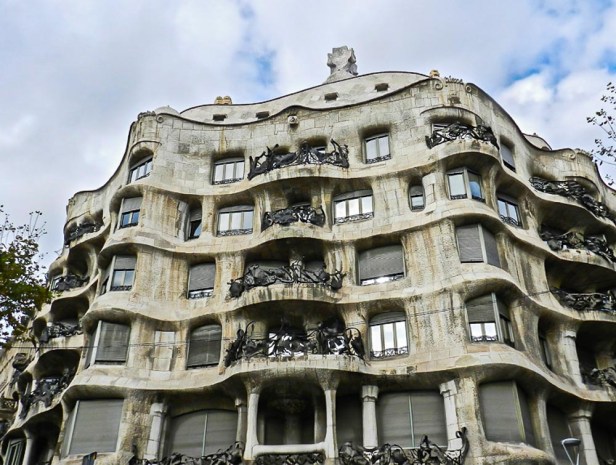
chimneys and air vents,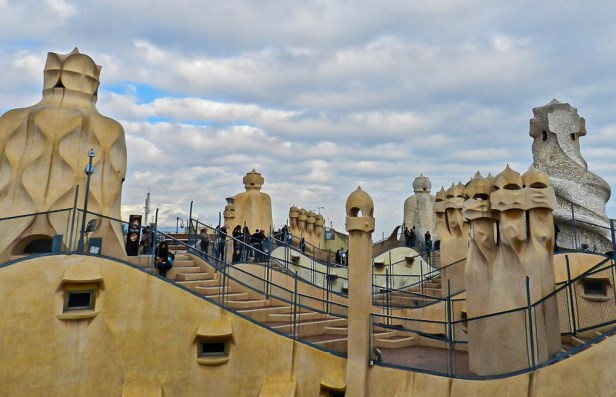
and the lobby.
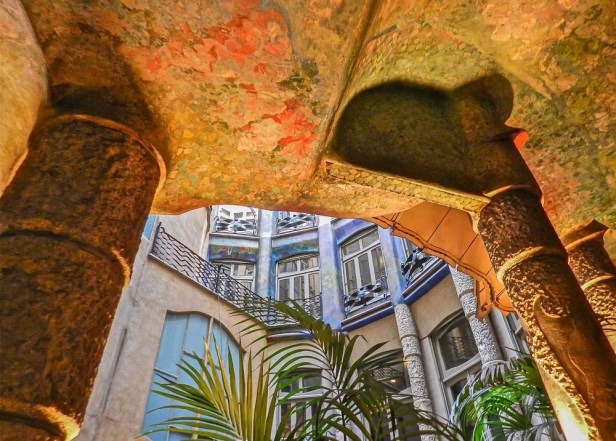
Gaudi was responsible for the design and construction of other unique private homes in Barcelona, but the most astonishing of Gaudi’s buildings has to be the Basilica of La Sagrada Familia.
It almost defies description. The scale is enormous – 4500 square meters of interior space. The interior design is heartbreakingly beautiful, and the energy one of grace and blessing, even with hundreds of people wandering around in there. We were both completely stopped by the sheer beauty of this most reverent and unique expression of Gaudi’s astonishing creativity, spiritual vision, and passion.
It was begun in 1882. Since Gaudi’s death in 1926 different architects have continued with the building following Gaudi’s ideas; retired architects and builders volunteer their time. It is hoped the exterior will be completed by 2026, the 100th anniversary of Gaudi’s death.
My pictures of the interior don’t give any sense of the enormous size of the space, and the feeling of both spaciousness, and intimacy. Gaudi’s intention was that all the columns would give the impression of being in a forest, and there is the feeling of the cathedral-like nature of a forest, but there is also this huge open space in the centre with the altar at one end. The place is enormous without feeling cavernous. It doesn’t matter if you’re Catholic or not, it doesn’t even matter if you’re religious or not, Gaudi’s basilica is one of the great gifts to the world.
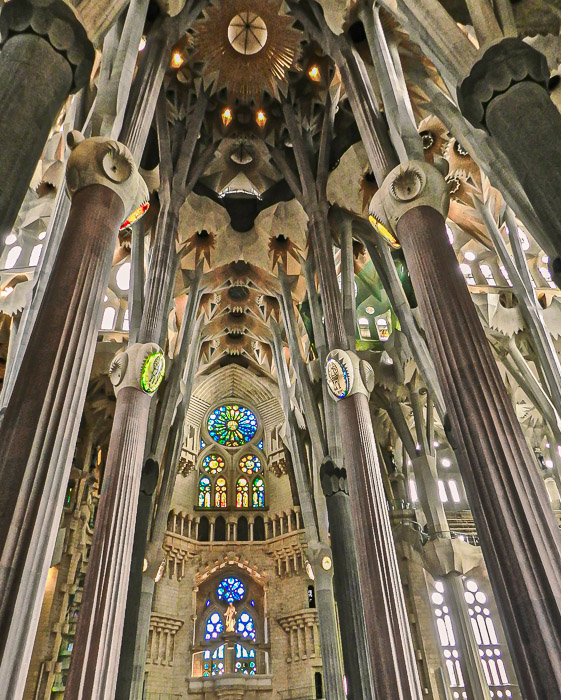
Egypt 2015
Arab proverb: Man fears time. Time fears the pyramids. The pyramids were royal, revered burial monuments dominating the Plains of Giza far from the city. Insistent, unassailable, undeniable, sacred. Several thousand years later the pyramids still inspire awe. Approximately 2.3 million blocks of stone were cut and assembled to create the Great Pyramid of Khufu. It is an almost unimaginable feat. And that is for only one of the pyramids. There are two more of almost equally monumental size standing next to it, and several smaller pyramids throughout Egypt. There is nothing in the world like them.
Guatemala 2017
From Sagrada Familia, one of the grandest cathedrals in the world, to a modest village church. In San Pedro Las Huertas, a short distance from Antigua, we are impressed by the bold colour and beautiful Baroque details of the local church.
Japan 2018 and 2019
About two hours by train from Tokyo is the town of Nikko, and near Nikko there is an extensive UNESCO World Heritage Site consisting of two shrines and a temple, with a total of over 100 buildings. The star of them all is the Tōshō-gū Shrine. The imposing entrance to the shrine is the Yomeimon Gate, symbolizing the passage from the mundane into the sacred. One should not pass lightly through a gate such as this, but these days most people do.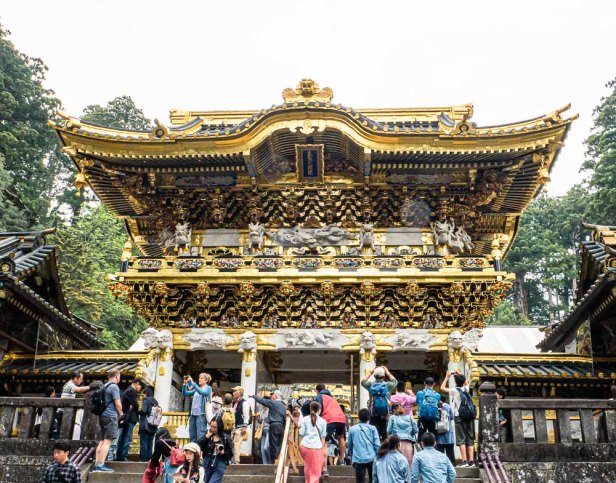
In 1950 a disturbed young monk burned down the five-hundred–year-old Rokuon-ji Temple in Kyoto. In 1955 it was rebuilt as a close replica of the original. Today the temple is known as Kinkaku-ji, or the The Temple of the Golden Pavilion. Even having seen photos before hand, I am still not prepared for the shimmering splendour of it. I think the young troubled monk did us all a favour. I looked at photos of the building that he burnt down. It had lost almost all of its gold leaf and the old wooden building seemed ramshackle at best. The replacement, built in 1955 is a perfect little gem and an exquisite example of Japanese beauty.
Kiyomizudera Temple, one of the most celebrated sites in Japan, was founded in 778 CE. Spread gracefully over the side of a mountain in eastern Kyoto the temple comprises thirty Buddhist buildings. Most of the temple buildings have been burned to the ground and rebuilt time and time again. Those that still stand date from the 1600’s, a testament to the perseverance of the faithful, and the deeply held recognition of the site as sacred.
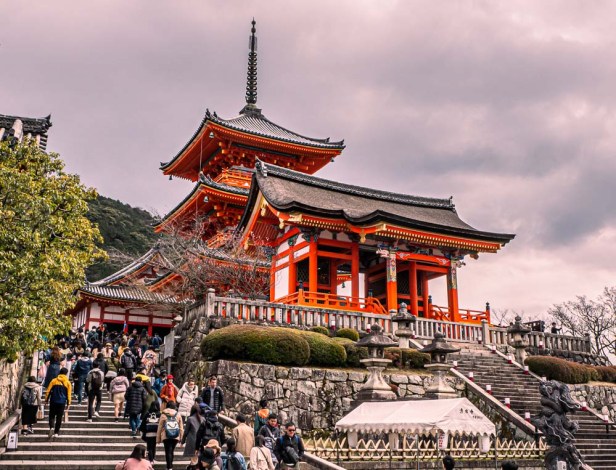
China 2018
It’s a three-hour hike from the road up the side of Emei Mountain, one of China’s four sacred Buddhist mountains, to Hongchunping Temple. The temple buildings, all weathered wood and grey slate tiles, have a timeless sense of belonging, as if the mountain has embraced them. It is a serene space with the patina of age highlighted by freshly painted decorative details.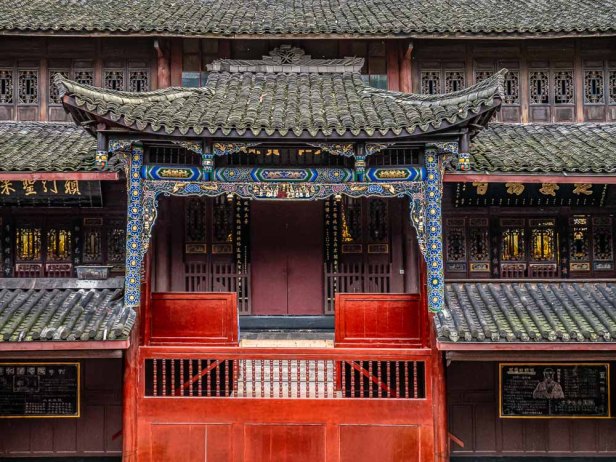
From the top of the ancient city walls that surround the old city of Xi’an one can look down on the Yongning International Art Museum, an exquisite example of traditional Chinese architecture.
The Forbidden City. For a start it’s huge! Within the walls there are 980 separate buildings, all built in the same style, with over 8700 rooms. The entire complex covers over 180 acres, which is the size of about 136 football fields. The enclosing rectangular wall is eight metres high and beyond that is a moat six metres wide and 52 metres deep. For hundreds of years it was the closely guarded enclave of a very select few, catering to the whims and wishes of the emperor, the most important person in the land.

Canada 2018
Inaugurated in 1847, Marché Bonsecours in Old Montreal is recognized as one of Canada’s outstanding heritage buildings. It is the headquarters of the Québec Crafts Council, as well as housing restaurants and boutiques featuring top-quality “made in Québec” creations such as crafts, fashions, accessories and jewellery, and reproduction Quebec furniture.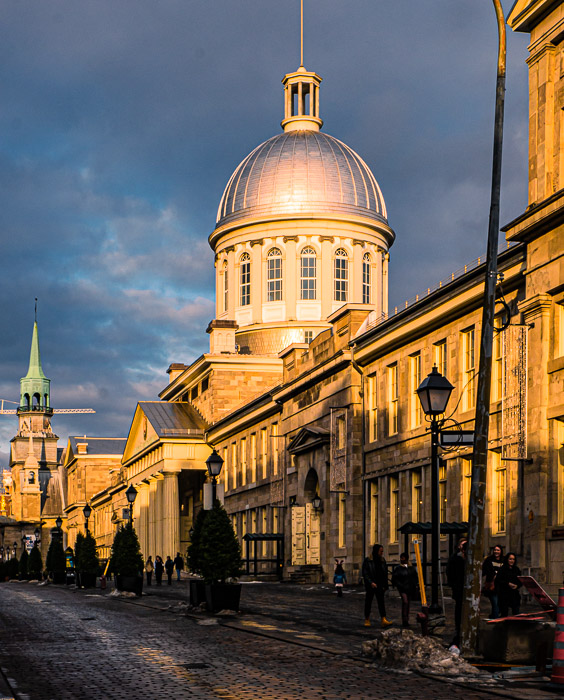
France 2019
You can see the steeples that loom above this glorious 13th-century building almost immediately you leave the train station, one a Gothic frivolity, the other austere Romanesque.
Cathédrale Notre-Dame de Chartres is built on the highest point in the area, a site that has been a place of worship since ancient times. There was a Celtic temple, a Roman temple, then five – five! – cathedrals since Chartres became a Bishopric in the fourth century. The cathedral that stands today was built from 1205 to 1270. We were held in thrall by this extraordinary building for almost two hours. There are the two contrasting steeples, flying buttresses, hundreds of sculpted figures depicting theological themes and stories, and both Romanesque and High Gothic sculpted portals. And that’s just the exterior.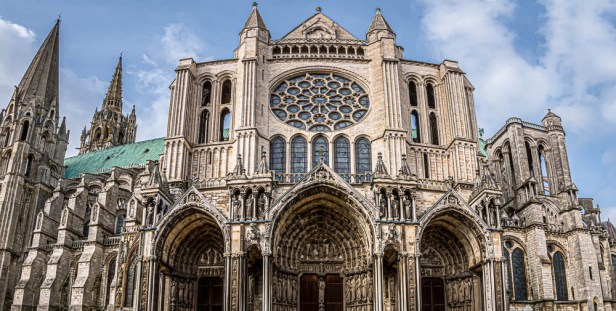
The interior takes my breath away with its soaring beauty; it is almost a transcendent experience. This is, of course, exactly what the architects of the Gothic style were hoping to achieve.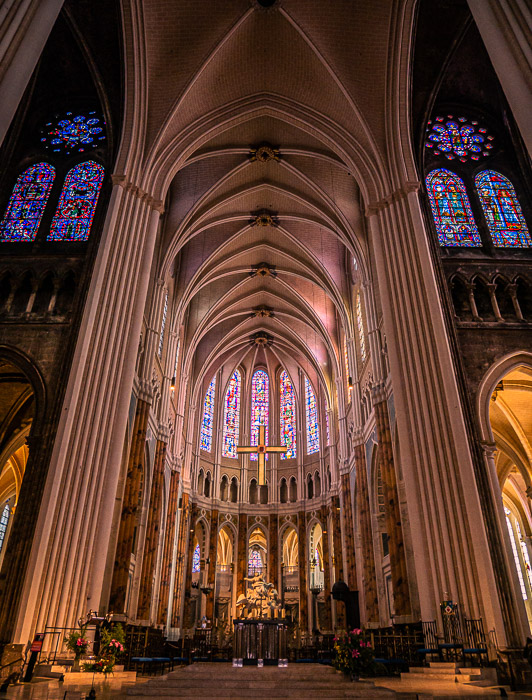
One day nearing sunset, on our ramblings around Paris, we come across the metal and glass beauty of the newly restored Le Carreau du Temple, a classic example of 19th century French construction. Originally a covered clothes market, today it hosts events, fairs and short exhibitions.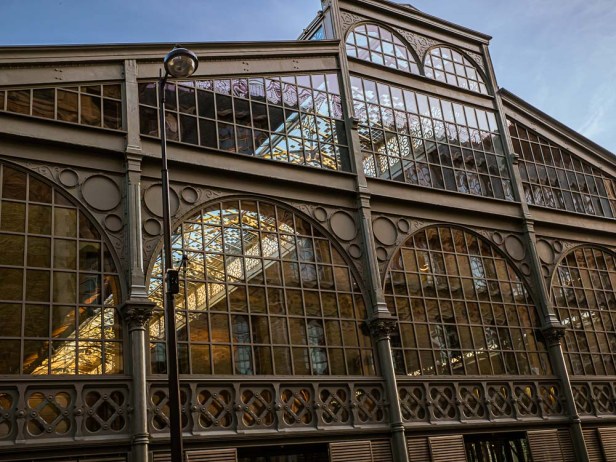
Sacré Coeur sits like a confection of white meringue against the sky. This Roman Catholic Basilica is located on the summit of the highest point in Paris, the Mount of Martyrs (Montmartre), a place that has been a site of worship since the time of the Druids. It was built between 1875 and 1919.
It’s about a twenty-minute walk from Sacré Coeur to St Denys-la-Chapelle, the Chapel of St Denis, situated on the spot where he died. How he got there is the stuff of legends. The original Christian chapel on Montmartre was built in about 270 CE to honour St Denis who was the first Bishop of Paris. The story goes that after he was beheaded by the Romans, St Denis picked up his head and carried it on a twenty-minute stroll while his mouth gave a complete sermon. With the sermon over he closed his mouth and fell down dead never to rise again. And today on that spot sits the chapel that honours him.
It took a long time and many visits for Galeries Lafayette to get to the top of my Paris wish list. I didn’t understand why a department store would be a tourist attraction. Back in 1893 two cousins decided to establish a novelty store on Rue La Fayette. They called it Aux Galeries Lafayette. It was a great success, and after the purchase of several adjacent buildings and years of refurbishing, the ambitious and enormous Galeries Lafayette was officially opened in 1912. The architects designed the Art Nouveau store around a glorious neo-Byzantine 43-metre high dome. When I finally see it, it literally takes my breath away. I hardly know how to hold such splendour. How does one take it in, this artistic and creative brilliance? I can only stare in gratitude for such beauty. If all department stores looked like this I might go shopping more often.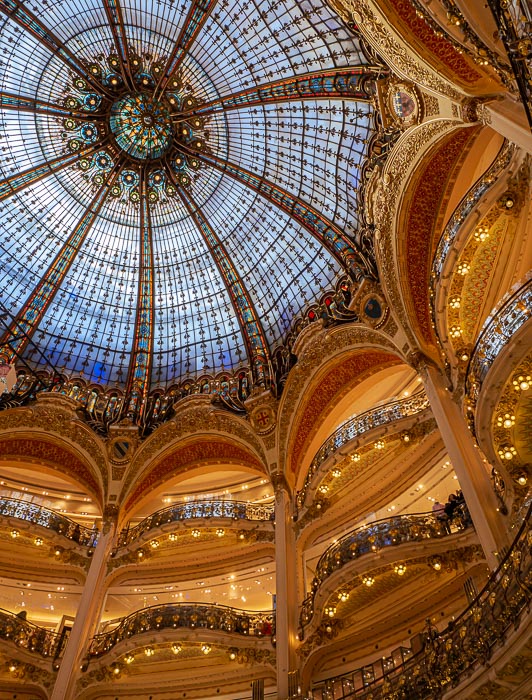

In 2008 I go inside Notre Dame de Paris and shuffle along behind a few hundred other tourists. My only photos of that time are of the stained glass windows, and I have no memory of actually seeing the interior. We didn’t climb the tower because of the long line-up. On our 2019 visit I’m determined to see inside no matter how long I have to wait. It’s winter in Paris; there is no line-up! How sad and appalled I was by the fire just two months after we were there that has seen the closing of the cathedral until further notice. How lucky and grateful I am that I finally got to see the glorious interior, and climb the tower before that happened. May this Gothic grand dame of cathedrals be repaired soon and be better than ever. May the repairs be a gigantic perfect piece of kintsugi!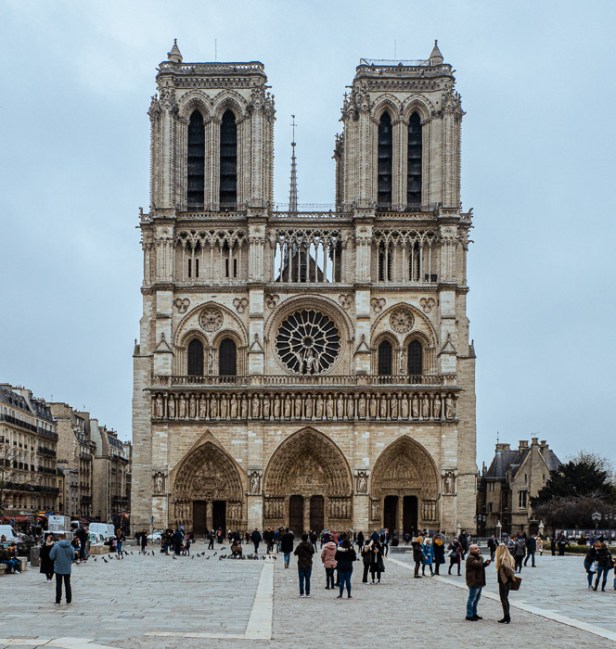

Malaysia 2020
The Sarawak State Legislative Assembly Building in Kuching was opened in 2009 and dominates the riverbank. The building is a nine-pointed star with a roof echoing that of a traditional Malaysian royal umbrella, a cultural icon of both Kuching and Sarawak.


Next post: New Westminster’s Columbia Street Festival – street performers, music, and foooooood! It’s an annual food truck festival. Best lobster roll! Best gelato!
All words and images by Alison Louise Armstrong unless otherwise noted. © Alison Louise Armstrong and Adventures in Wonderland – a pilgrimage of the heart, 2010-2021.

I’ve seen so many of these buildings and felt such awe … Gaudí’s work in Barcelona was amazing I enjoyed seeing these Alison I also remember walking through Tiananmen Square…I felt such outsider…thanks for reminding me of these spaces and places…look forward to your New West post too ☺️🤓 enjoy the summery days ~ sending joy hedy
LikeLiked by 2 people
Thanks so much Hedy, my pleasure. Glad you enjoyed. When I was in Tiananmen there were huge crowds of domestic tourists, plus our group. I think we were the only westerners there, but at least I was in a group.
I too am a big fan of Gaudi’s work. What a visionary!
Happy summer!
Alison
LikeLiked by 1 person
Awesome…. The buildings & the research. Have visited the Japanese & Chinese structures.
LikeLiked by 1 person
Thanks so much Indra. I enjoyed putting this post together, and the previous one of buildings – reminded of what we’ve seen, and how creative us humans are.
Alison
LikeLiked by 1 person
There is so much to see and appreciate …. Time is flying past
LikeLiked by 1 person
Lovely and soo beautiful… Missed seeing your posts… The pics are really beautiful 😍
LikeLiked by 1 person
Thank you so much Neethu. I’m glad you enjoyed.
Lovely to have you back!
Alison
LikeLiked by 1 person
I’ve seen a few of these structures. Some only in the outside, but it’s all good. Can you believe I actually became blasé about cathedrals after living in Europe for over a decade?
LikeLiked by 1 person
Sad to say I can still count on one hand and one extra finger the number of European countries I’ve been to. And three of those are largely protestant so no huge ornate RC cathedrals, so they’re still a novelty to me, though I can imagine one would become blasé after a while. Too much of a good thing I guess. Still, I would love to go back to Europe and explore more until I too feel saturated.
Alison
LikeLiked by 1 person
You have some of my favourites in there. Love the Alhambra! Your photos of the Gaudi sites are magnificent. The government building in Kuching is so cool–another reason for me to Borneo!
LikeLiked by 1 person
Thanks so much Caroline. I’m pleased that you like my Gaudi photos. They were taken way back when I was really just beginning with photography. I guess I was “seeing” something though think I would do so much better now. Plus I have a much better camera now lol.
The Alhambra is amazing isn’t it! And yes, you must get to Borneo – it’s a really special place.
Alison
LikeLiked by 1 person
These are take-your-breath-away buildings! I have been to some and now have learned about a few new ones. A great tribute to the architecture and atmosphere of these places.
LikeLiked by 1 person
Thanks so much Ruth. We’ve been to so many extraordinary buildings, but it was actually a reader who suggested I do a post about them. I’m so grateful because I would not have thought of it, and it’s really highlighted how truly amazing, how creative, human beings can be.
Alison
LikeLiked by 1 person
Some of the buildings you mention here have been on my wishlist for quite some time, including the Alhambra and the Yomeimon Gate — who wouldn’t be impressed by those intricate details? But I’m also curious about that legislative assembly building of Sarawak. I’ve seen photos of it and that has become one of the main reasons for me to visit East Malaysia (I’ve been to the country multiple times, but never to the east).
LikeLiked by 1 person
Oh I do hope you get to the Alhambra and Tōshō-gū Shrine one day. Both are definitely worth seeing. Also Kuching is worth a visit. We really liked it, and Sepilok of course to see the orangutans.
Alison
LikeLiked by 1 person
Another fine collection, Alice! I always enjoy them. They are all beautiful but I am slightly prejudiced for Gaudi’s La Sagrada Familia because of its truly unique character. I stood in awe when I went inside. –Curt
LikeLiked by 1 person
Thanks so much Curt. I too was super impressed with Sagrada Familia. What a vision!
Alison
LikeLike
Jaw dropping. 🙂
LikeLiked by 1 person
I feel lucky to have seen many of these in person but also fortunate to see them again here as a collection – a wide-ranging example of human-built beauty that (almost?) rivals the natural wonder of our world!
LikeLiked by 1 person
Thanks so such Lexie. We humans are so darn creative, and yes I do think our creativity rivals (almost) the natural world. We can be genius at creating beauty.
On the other hand I remember when Notre Dame burned billions were raised almost immediately for the restoration and there was a meme going around Facebook saying “Save this cathedral” with a picture of an old growth forest, and I know which I’d rather was saved. Hint it wasn’t the building.
Alison xo
LikeLiked by 1 person
Haven’t been very many places, so I very much appreciate all of our photos.
I loved the opportunity I once had to sing in the Washington National Cathedral (Washington, D.C.). Sound rises up to the heavens because of the stone and very high ceilings.
In my lifetime, I have been out of the USA only once—I went to Japan.
Rather intimidating, as it was the first place I had ever been where I could not understand the language. I did take a photo of the Golden Pavilion, and it is very similar to your photo above (for once I can say….Hey, I’ve actually been there!”) 🙂
It was a very impressive sight.
LikeLiked by 1 person
Thanks so much Mary, my pleasure. Aren’t the acoustics in cathedrals amazing! I went to a Carols by Candlelight evening in a cathedral in Montreal and the sound was truly uplifting.
The Golden Pavilion is a building I’ll never forget. I think it’s one of those buildings that all the pictures in the world cannot really prepare you for the stunning reality of it.
Alison
LikeLike
Wonderful post bringing back some favorites and introducing some new ones. I like the bouquet of choices ~ so many contrasts !
A few years back we were fortunate to have a two week home exchange with a view up to the Alhambra ~ It was glorious watching it at dusk and in the morning light and all the times in between. I think my favorite Gaudí work us the park in Barcelona! But yes the creativity and magic are like nothing else I’ve seen !
Loved the temple of the Golden Pavilion although it was rather crowded even in December!
Peta
LikeLiked by 1 person
Thanks so much Peta. I’m always amazed by the variety of buildings around the world. Human beings are so creative!
I can only imagine how fabulous it must have been to have a view of the Alhambra. What a great home exchange. I also loved the Gaudi park, but Sagrada Familia remains my favourite. He was such a visionary.
I remember the Golden pavilion being crowded when I went in May (during Golden Week!) but still managed a good place for photos across the lake. When I went back in March with Don it was much quieter. But for sure I understand why it gets so busy – it’s so worth seeing.
Alison
LikeLike
Compellingly different, Alison. So much beauty in one post!
LikeLiked by 1 person
Thanks so much Jo. We humans sure are a creative bunch, and it’s buildings like these that show what beauty we are capable of creating.
Alison
LikeLiked by 1 person
I feel as though I have just opened the pages of Architectural Digest. Fabulous photos as always Alison. I always find building so difficult to give the true scale to. I feel you have really accomplished that.
LikeLike
Thank you so much Sue. What wonderful compliments. You’ve made my day! (I’m lucky that I have photographer sisters to teach me things.)
Alison
LikeLiked by 1 person
Some amazing buildings here. I love The Alhambra! Your pictures are fabulous.
LikeLiked by 1 person
Thanks so much Darlene. Glad you enjoyed it.
We too loves the Alhambra. What a place!
Alison
LikeLiked by 1 person
Absolutely awesome. You are a wonderful photographer and artist. My husband was an architect in Tennessee, so we visited many of those in Europe and had planned to go to Barcelona this September, but the Covid numbers are climbing in that area and things are shutting down again. Soo sad. Grateful that I get to travel vicariously with you.
LikeLiked by 2 people
Thank you so much Eileen. I’m glad you enjoyed the post. I imagine if your husband was an architect you’d know a thing or two about special buildings.
I’m so sorry you missed Barcelona. I hope you get there eventually. Gaudi’s buildings really are amazing. He was one of a kind that’s for sure.
Alison
LikeLike
The very spare photo of the pyramids after Gaudi’s work is a wonderful juxtaposition, really bringing home the incredible variety of architecture that humans have created, throughout the millennia and across the globe. How lucky you are to have seen so much, including Notre Dame before the fire. Your determination paid off.
LikeLiked by 1 person
I’m so glad you noticed the juxtaposition of the pyramids after Gaudi’s amazing work. I hadn’t noticed it myself, and it’s such a statement about human creativity!
I agree, so very lucky to have seen so many special buildings. There are even more I haven’t included mainly because I didn’t have decent, or any, photos of them – like the extraordinary Sydney Opera House, and Sainte Chapelle.
I had that one earlier visit to Notre Dame when I shuffled along in the crowd, but I also walked straight past a couple of times after seeing the lineup, so to be able to go in and see it with very few people, and to be able to climb the tower before the fire – sooo lucky.
Alison
LikeLike
A great read Alison. Having visited many of the places, you’ve provided inspiration when time permits to visit other places.
LikeLiked by 1 person
Thanks so much Marilyn. I’m glad you enjoyed. Hope you get to the places you’ve not been to yet!
Alison
LikeLike
This is an awesome bucket list of buildings to see, I’m halfway through and looking forward to ones I’ve never heard of and loved seeing Montreal on the list.
LikeLiked by 1 person
Thanks so much Faith. I hope you get to see some of them. If we ever get to travel again 😳
I think Bonsecours is a beautiful building. I love Montreal 🥰
There are so many others I could have included, in Paris, and in Australia, but I had to stop somewhere.
Alison
LikeLike
I love this series! Such a great way to showcase incredible architecture around the globe. Each one unique and spectacular in their own way. Spain and France architecture have a special place in my heart, but love that Montreal was included too!
LikeLiked by 1 person
Thanks so much Renee. It was actually someone who commented on a post about wildlife around the world who suggested I do buildings. I’m glad he did – there are so many amazing buildings.
There were a few more from Paris I could have included, but had to stop somewhere. I haven’t seen nearly enough of Spain! Or France for that matter.
I love Montreal. We go almost every year for Christmas with family. Are you close? It would be lovely to meet in person.
Alison
LikeLike
I am sad to say I’ve only visited the buildings in France and Barcelona detailed in your post although Spain is on my list for the future. I am lucky that I have seen other amazing buildings around the world and always delight in their design and intricacy.
LikeLiked by 1 person
Oh I’m sad 😢 too that I’ve not seen more of Europe. So much world so little time . . . . . (And honestly sometimes I wonder if we will ever travel again.)
There are so many amazing buildings, even more I could have included here. For sure they’re a big part of what we go to see when travelling.
Alison
LikeLiked by 1 person
As a Civil Engineer, I am a building geek. I am always looking at the technical design. And have found so many beautiful buildings around the world. I am so glad we have seen so many of the amazing buildings featured in your post. But need to add the inside of Sagrada Familia to our future travels. The other one on our list for Paris is Sainte-Chapelle. I heard the stained glass is stunning.
LikeLiked by 1 person
Oh it must be amazing to look at buildings through your eyes. So often I wonder about construction – how did they *do* that?
I really should have included Sainte-Chapelle. It is absolutely stunning. As is the interior of Sagrada Familia. I hope you get to both.
Alison
LikeLike